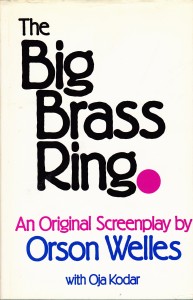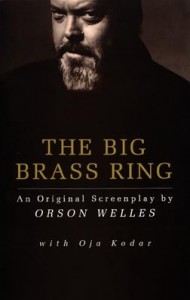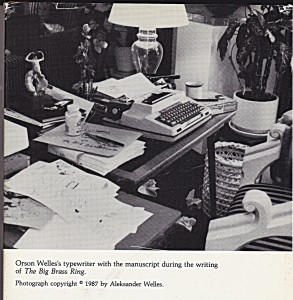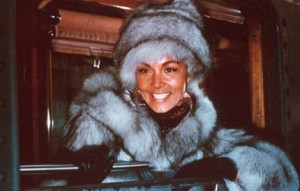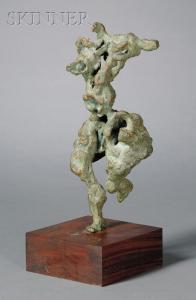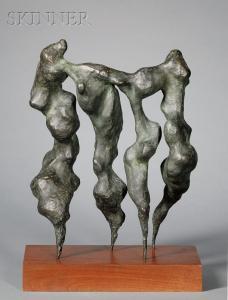Published with the screenplay by Santa Teresa Press in the fall of 1987, and reprinted in my 2007 collection Discovering Orson Welles (along with the introductory paragraphs that follow, tweaked and abridged somewhat). The photograph of Welles’s typewriter reproduced below was taken by Kodar’s nephew, Aleksander (“Sasha”), and Oja herself can be seen lurking indistinctly in a corner. (What I presume is one of her sculptures, on the desk, is more visible.)
When I presented [a] Welles tribute at the Santa Barbara film festival in 1986,
one person in the audience who introduced himself to me afterwards was James
Pepper, a local rare book dealer who, in response to my assertion that the Welles screenplay for The Big Brass Ring should be published, expressed some interest in bringing out a limited edition of 1,000 copies. Having already brought out a handsome volume devoted to Robert Towne’s original screenplay for Chinatown in a similar way, he seemed to know what he was talking about, and I conveyed his proposal to Oja Kodar [whom I had recently met at the Rotterdam Film Festival].
The following year, around the time I was preparing to make a permanent move to Chicago to write for the Chicago Reader, the book appeared. And it was roughly two years after then that Gore Vidal published a rave review in the New York Review of Books (“Remembering Orson Welles,” June 1, 1989, vol. 36, no. 9) that finally accorded the screenplay the literary attention and respect I always believed it deserved — in an engaging (if not exactly scholarly) autobiographical piece about Welles that also reviewed Frank Brady’s more recent biography. The same essay has subsequently been reprinted in a couple of Vidal’s collections and elsewhere (including Orson Welles Interviews, edited by Mark W. Estrin [Jackson: University Press of Mississippi, 2002]). That all its multiple appearances have come long after the book went out of print and disappeared from sight [although, to be fair, it can still currently be found inexpensively on Amazon, in its 1991 English paperback reprint, published by Black Spring Press] has seemed to me a paradigmatic illustration of “Wellesian” mistiming — a problem that dogged his film career and continues unabated posthumously. (My major regret about Vidal’s essay is his lack of familiarity with Oja Kodar and F for Fake, which limits his lucidity about some of the script’s more personal elements.) I hasten to repeat, however, that anyone who wants to track down this book can still do so. In 1989, it also came out in Italian as La posta in gioco.
Ten years later, in 1999, George Hickenlooper released a film of the same title, adapted very loosely with F. X. Feeney from the Welles script, with the characters, plot, and much of the dialogue radically altered and the locales shifted to St. Louis from parts of Spain and to Cuba from Africa. Having expressed my regrets about this feature in “Fables of the Reconstruction: The Four-Hour Greed,” I see no point in repeating them here, except to say that I tried very hard to get the Welles script reprinted around the same time by the University of California Press, partially in order to clarify that Welles couldn’t and shouldn’t be blamed for the film. Although Oja agreed on principle to this reprint both times I lobbied for a contract, she failed on both occasions to sign the contract that emerged, with the lamentable consequence that the Hickenlooper film continues to have much more visibility and currency than the work by Welles that inspired it. Since this protracted frustration, I haven’t tried to promote any more publications or reprints of works by Welles.
Because the afterword that follows assumes the reader’s detailed familiarity
with the screenplay, it may not always be easy to follow. A perusal of Vidal’s essay, for anyone who has it handy, should clear up most of these difficulties. — J.R.
He is a great man — like all great men he is never satisfied that he has chosen the right path in life. Even being President, he feels, may somehow not be right. He is a man who has within him the devil of self-destruction that lives in every genius. You know that you’re absolutely great, there is no question of that, but have you chosen the right road? Should I be a monk? Should I jerk off in the park? Should I just fuck everybody and forget about everything else? Should I be President? It is not self-doubt; it is cosmic doubt! What am I going to do — I am the best, I know that, now what do I do with it?
Hannibal crossed the Alps with the second greatest army in classical history. He arrived at the outer gates of Rome and Rome was in his hands, ready to be taken. At the outer gates, he stopped and went back. What made him stop? That same devil — this thing that always stops conquerors at the moment of victory. That is what The Big Brass Ring is about. Also: There is this foolish, romantic side of us all, that puts us into these absurd, even ridiculous situations and positions in life. That is what the circumstances of the film are about — the theft of the necklace, the situation with the monkey, etc. All these idiotic events that one’s romantic nature leads one into.
— Orson Welles to Henry Jaglom, in a memo from Jaglom to Jack Nicholson, dated May 20, 1982, during the efforts to launch THE BIG BRASS RING
The rift between public and private life that figures so prominently in the work of Orson Welles, from CITIZEN KANE to THE BIG BRASS RING, is ironically a factor that has tended to obscure substantial portions of his own life and work. An intensely private man himself, in spite — or should one say because? — of his expansive public image, especially during the latter portion of his life, Welles played Menaker to his own Pellarin (and vice versa) in more ways than one. While he remained in the public eye throughout his career, principally as an actor and performer, a large portion of his creative work as writer and director was kept firmly under wraps, for a number of reasons. (1)
If it seems likely that the closest we will ever get to a spiritual autobiography of Welles will be the work he left behind, it will probably be a good many years before we can even begin to see the full shadow of his profile, much less assess it. Since his death at age 70 on October 10, 1985, it has become increasingly clear that the legacy he left behind — a wealth of material including countless films, scripts and projects, scattered over many years and countries, in different stages of completion or realization — is immeasurably larger and richer, and more full of potential surprises, than any of us had reason to suspect.
Oja Kodar — Welles’s companion, muse and major collaborator over the last two decades of his life, to whom he entrusted this legacy — has dedicated herself to the formidable task of making available as much of this work as possible. But the obstacles she has to face, many of them continuations of the same financial and logistical difficulties that blocked these projects when Welles was alive, are a good deal more daunting and complex than one might initially assume. Welles essentially left behind two estates — one of them controlled by his wife Paola Mori and daughter Beatrice (complicated still further by the death of Mori in 1986), the other controlled by Kodar and it is only recently that a final settlement has been reached. This is one reason why the publication of The Big Brass Ring represents a major step forward in the clarification of the invisible Orson Welles, even though it comprises only a piece of the iceberg (or jigsaw puzzle, if one prefers).
As a sample of Welles’s creativity in his mid-sixties, this original screenplay offers ample evidence that he was continuing to move in fresh and unexpected directions. Yet to call it “characteristic” of his late work in any but the broadest terms would be misleading, if only because every Welles project represented a fresh departure — a virtue that regrettably kept him “unbankable” as a director throughout most of his career. Spectators looking forward to “another” CITIZEN KANE would be confounded by the challenges of TOUCH OF EVIL, and by the time they had caught up with the brilliance of the latter film, Welles was somewhere else again — thereby frustrating the principle of supply and demand that could sustain a Chaplin, a Hitchcock or even a Godard.
By conservative estimate, in the 1980s alone Welles was working on at least a dozen separate film projects, no two of them alike — including a film set in Hollywood in the early 1970s, THE OTHER SIDE OF THE WIND (which was begun during that period), THE MAGIC SHOW (a collection of some of his best acts of prestidigitation, all done without camera tricks), DON QUIXOTE (which he had been working on intermittently since the 1950s), a fiction film about Sirhan Sirhan (THE ASSASSIN), adaptations of Graham Greene (THE OTHER MAN, based on The Honorary Consul) and Jim Thompson (DEAD GIVEAWAY, based on A Hell of a Woman) and Isak Dinesen (THE DREAMERS), a radically conceived KING LEAR to be shot in black and white close-ups, an exercise in autobiographical self-scrutiny set in the mid-1930s (THE CRADLE WILL ROCK), and a development of a short story by Kodar (MERCEDES, based on her “Blind Window”) which he started work on the summer before he died. While only some of these —- THE OTHER SIDE OF THE WIND, THE MAGIC SHOW, DON QUIXOTE, and THE DREAMERS — advanced beyond script and preproduction stages, nearly all of the scripts went through countless revisions; there are nine drafts of THE DREAMERS alone.
THE BIG BRASS RING was a unique project of this period insofar as it sprang from material that was completely original with Welles and was started at the urging of a friend director Henry Jaglom — rather than at Welles’s own instigation. Jaglom had already been trying without success to help Welles secure financing for THE DREAMERS, one of the latter’s most cherished projects, and one day, in February or March 1981, he suggested that Welles write something more commercial and contemporary — an original script which could entice producers. After some reluctance, Welles began telling him stories over a series of lunches, and Jaglom describes the outcome as follows:
…Finally he told me one he’d been thinking about for years, about an old political advisor to Roosevelt who was a homosexual, and whose lover had gotten crippled in the Spanish Civil War fighting the fascists. Now he was in an African kingdom, advising the murderous leader and back in the U.S., a young senator,who’d been his protégé, was going to run against Reagan in 1984, as the Democratic nominee. And I said, “Great! My God! That’s great! Write that!” And he said, “Oh, I can’t. I can’t possibly.” And I said, “Please write that.” And he said, “No,there’s no way.”One night, about six days later, I got a phone call. He said, “I’ve got four pages.” He was sweating; I could hear it: “Could I read them to you?” I said, “Sure,” and he read to me — and I said, ‘My God, they’re brilliant! Please keep on writing. And he said, “What are you, crazy? It’s four in the morning; I’ve got to go to sleep.”
The next day he came to lunch, and he had 12 pages. And the next day he had 23. And in three months he had a script, one which I just could not believe. It was called THE BIG BRASS RING. It was absolutely the bookend to CITIZEN KANE. It was about America at the end of the century — socially and politically and morally — as KANE and AMBERSONS are about America at the beginning of the century. (1)
After some casting about, Jaglom eventually found a willing and enthusiastic producer, Arnon Milchan, who was working at the time on THE KING OF COMEDY (his subsequent credits include ONCE UPON A TIME IN AMERICA and BRAZIL), and agreed to furnish an eight million dollar budget, pre-selling the film in foreign markets, if a “bankable” male star could be found to play Blake Pellarin. “He was amazingly clear about his job as a director in helping a producer,” Milchan recalls today, remembering lengthy phone conversations with Welles (whom he never met face to face) on subjects ranging from technical matters about the shooting to the treatment of sex — which would be “clear and felt” but not graphic. “He was really on top of it,” Milchan states with conviction.
Welles, estimated that he needed six million to shoot the film — figuring on location work in Spain, filming the yacht scenes near Los Angeles, and a limited amount of studio work (possibly in Rome) for the hotel interiors — so it was decided that the remaining two million plus ten per cent of the profits would be used to lure the male star. To Milchan and Jaglom, the strategy seemed foolproof, and with Welles a list of six possible actors was drawn up: Warren Beatty, Clint Eastwood, Paul Newman, Jack Nicholson, Robert Redford and Burt Reynolds. (At earlier stages, before the ‘bankable” star strategy was hatched, Welles contemplated using a real-life couple to play Blake and Diana Pellarin — John Cassavetes and Gena Rowlands at one point, Cliff Robertson and Dina Merrill somewhat later; James Caan was also considered, but never approached.) But over the next year or so, they made the unhappy discovery that none of the six actors was willing to accept the offer unconditionally. Eastwood, Newman, Redford and Reynolds all simply declined, each giving a separate reason. Nicholson, who was Welles’s first choice, asked for a larger sum, arguing that, after working hard for years to raise his asking price, he could not settle for two million without reducing his future fees. Beatty, Welles’s second choice, fresh from having just shot REDS, agreed to play the part if he could produce the film and have final cut — a condition that he realized that Welles would find impossible. By late 1982, the project was effectively dead.
The version of the script printed here, the last of many drafts, is dated June 22, 1982. An undated early version, probably written about a year before, follows the same general plot outline except for one very striking difference: the climactic murder of the blind beggar is committed by Kim Menaker, not Blake Pellarin. Except for this change, the description of this scene is almost identical, apart from some echoes of the children’s chant, “Quiene tiene miedo del tri-mo-tor” (sung to the tune of “Who’s Afraid of the Big Bad Wolf?”), recalled earlier by Menaker in the Retiro Park — hoarsely half whispered by Menaker as he enters the neighborhood, and later heard as a ghostly echo in his brain (along with laughter and a “scampering of little feet”) after he kills the beggar. (2)
Although Welles ultimately chose to have Pellarin commit the murder, for a number of reasons, he significantly reassigned the crime to Menaker in one or more of the intermediate versions of the script, apparently on the basis of whether he thought the male star being approached could convincingly carry off the scene or not. The fact that he contemplated both alternatives is certainly revealing both of the flexibility of his conception and of the larger sense that Pellarin and Menaker (like Marlow and Kurtz in HEART OF DARKNESS, his first Hollywood project) are different sides of the same coin, both of them Wellesian self-portraits. It is important to recall that, like Menaker, Welles had been a friend of Franklin Roosevelt and occasionally wrote speeches for him — and that, like Pellarin, he was once regarded as a serious political hopeful, having come very close in the mid-1940s to running against Joseph McCarthy in Wisconsin as a Democrat for a seat in the Senate. Kodar recalls a political conversation with Welles which had a particular bearing on this scene, and helps to explain one of the reasons why Pellarin (whose name, accented on the first syllable, suggests pélarin, the French word for pilgrim) was the one who finally committed the crime: “You see, Orson did not like symbolism — nor do I.” Once, however, he admitted to Kodar that he was guilty of symbolism in his depiction of the murder of the blind beggar. After complimenting Kodar on her smile and the whiteness of her teeth, she remarked that this was partially thanks to America, recalling the aid packages she received as a child in Yugoslavia. They then discussed the dubious wisdom of the U.S. having showered Vietnam with bombs instead of aid packages, as well as the behavior of America after destroying much of Germany and Japan in World War 11, “throwing candies” at them and suffocating them with its “good intentions”. At which point Welles remarked, “I’m afraid I’m going to get into some symbolism in THE BIG BRASS RING. Because this beggar is going to be killed by this enormous wealth and health.”
 Kodar’s collaborative role on the script basically centered on the parts of Cela Brandini, which she was to play herself, and the unnamed French Cambodian woman whom Pellarin re-encounters in an empty house. But before examining her specific contributions, it would be useful to sketch in a bit of her own background. Coming from an intellectual family grounded in the visual arts, based mainly in Dalmatia — her Hungarian father and older sister are architects, another sister paints and makes tapestries, and her Yugoslav mother wanted to be a sculptor — she aspired to be a chemist (after seeing Greer Garson in MADAME CURIE) and writer (having published poetry when she was very young) before she settled on sculpture in her teens, and was the first woman ever admitted to the sculpture department of the Academy of Visual Arts in Zagreb. Sculpting mainly in stone and bronze, and more recently in African teak, her work is at once abstract, monumental and erotic. As a reviewer in the Tufts Observer wrote, “Kodar conveys, through abstract forms worthy of Matisse, the human form in all its malleable transigence.” She has had shows in Zagreb, Amsterdam, Paris, Rome, Boston, New York, and Los Angeles.
Kodar’s collaborative role on the script basically centered on the parts of Cela Brandini, which she was to play herself, and the unnamed French Cambodian woman whom Pellarin re-encounters in an empty house. But before examining her specific contributions, it would be useful to sketch in a bit of her own background. Coming from an intellectual family grounded in the visual arts, based mainly in Dalmatia — her Hungarian father and older sister are architects, another sister paints and makes tapestries, and her Yugoslav mother wanted to be a sculptor — she aspired to be a chemist (after seeing Greer Garson in MADAME CURIE) and writer (having published poetry when she was very young) before she settled on sculpture in her teens, and was the first woman ever admitted to the sculpture department of the Academy of Visual Arts in Zagreb. Sculpting mainly in stone and bronze, and more recently in African teak, her work is at once abstract, monumental and erotic. As a reviewer in the Tufts Observer wrote, “Kodar conveys, through abstract forms worthy of Matisse, the human form in all its malleable transigence.” She has had shows in Zagreb, Amsterdam, Paris, Rome, Boston, New York, and Los Angeles.
When she met Welles in Zagreb in 1962, while he was shooting THE TRIAL, she had just finished acting in a Yugoslav feature called A PIECE OF THE BLUE SKY, was working as an anchorperson on Yugoslav TV, and had recently written a story called “Girl-Watching” (which years later became the Picasso episode in F FOR FAKE). She accompanied Welles when he returned to Paris, but eventually left him to return to Yugoslavia. Two or three years later, she returned to Paris to attend the École des Beaux Arts, met Welles again and then remained with him for the next two decades.
Her first script collaboration with Welles was an unrealized adaptation of Poe’s “The Cask of Amontillado,” originally intended for a film collection of shorts by different directors, released in English as SPIRITS OF THE DEAD in 1969. Their work together on scripts — including F FOR FAKE, THE OTHER SIDE OF THE WIND, THE SURINAM (an adaptation of Conrad’s Victory), DEAD GIVEAWAY, THE ASSASSIN, THE DREAMERS, and MERCEDES — often consisted of Welles presenting a situation to her and getting her to ask questions and suggest alternatives. As she describes the process between them, it was a bit like playing Ping-Pong; sometimes she would improvise an idea while he took notes, avoiding interruptions which would unbalance her English: “When I felt it was still too murky and too fragile to be touched or manipulated by words, I would go into my room and talk into my tape recorder. And then, when it was wrapped and safe in this little box, I would bring it out and let him listen to that, and we would talk again about it.” On some occasions — including work on F FOR FAKE, THE OTHER SIDE OF THE WIND, and THE BIG BRASS RING — it involved combining stories which each of them had composed independently.
In the case of THE BIG BRASS RING, Welles decided to incorporate certain elements from an autobiographical story written in English by Kodar seven or eight years earlier — a story which he had originally titled himself, called “Ivanka” (a Yugoslav name which means “little Joanna”). “The story of the Asian girl and part of Cela Brandini come from “Ivanka,” Kodar explains. “There is something of Orson and myself in the story of the Asian girl, something that we lived. It’s not exactly that, but something like that happened.” When Pellarin describes to Menaker over the muted noises of the feria his former lover’s way of walking (page 114), this passage comes from a letter written by Welles to Kodar after they separated in Paris, a letter which was never sent, but which Welles continued to carry around with him for years, and which he showed Kodar only after he unexpectedly encountered her again in Paris. “When I met Orson again in Paris a few years later, he did not know that I was going to see him; it was a surprise. But he still had the letter, and that was the first time that I read it.” One might say, in other words, that it was the Pellarin in Welles who wrote the letter, and the Menaker in him who failed to send it.
“What I had in ‘Ivanka’ which we decided not to use — actually he fought for it at first, and I must say I didn’t want to give it to him, because I was keeping it for my story — was a scene in which Blake comes up from the cellar and pours his heart out to the girl, tells her everything — and finally discovers that she’s not there anymore. It’s a wonderful love declaration, and in a way a love scene, but he tells it to nobody.” This declaration would have been spoken in French, with English subtitles; its absence probably accounts, at least in part, for the scene’s sketchiness as it now stands. “He was going to have Blake explain himself — not only what he did to her, how he hurt her and how he needed her back, but he was going to say much more about himself. He came to a certain realization of himself — what he really was — because he was in too much pain at the moment, and when people are in pain they lose control. The pain opened all the sore spots in his soul, and he was saying everything — what he thought of himself, his future and his past.
When I took away this declaration and scene, in a way I was glad. Because I think — and actually it was Orson’s decision, but he wanted my opinion — it was better for Pellarin to remain partly an enigma to himself. This is why he is capable of going off singing on that train. Because he would become a better and cleaner man, an angelic guy, if he emptied himself. But if we wanted Pellarin to continue in his striving for the Presidency, he had to remain who he was: if he confessed, if he cleaned himself, he would have been left naked, he would have lost his armor.”
The character of Cela Brandini, on the other hand, was based on two independent sources. One was a somewhat comic character from “Ivanka,” based on a rather flashy member of the production crew on THE TRIAL who had a penchant for interviewing the directors she worked for as well as sleeping with them, and who tried unsuccessfully to seduce Welles — an event which Kodar witnessed herself. The other was the Italian journalist Oriana Fallaci, whom Kodar never met but read and watched on TV. To develop the part, she and Welles improvised scenes with a tape recorder in which her Cela would interview his Blake or Kim.
For the seasoned Welles enthusiast, THE BIG BRASS RING offers a tempting but ultimately deceptive trap: an apparent profusion of earlier touchstones in Welles’s career. Starting on the first page with the evocation of KANE in the depiction of Pellarin’s failed political campaign, the references continue with HEART OF DARKNESS (page 13), Welles’s radio persona (in the voice on Cela’s tape recorder, preceding Welles’s first appearance), TOUCH OF EVIL (in the opening dialogue of Jerry Kinzel on page 19 about leaving behind his wife Susie on a holiday trip) and DON QUIXOTE (page 35). When Menaker remarks that, “In a perfect world, all of us should be allowed some short vacations from our own identities,” the theme and world of THE DREAMERS — written just before THE BIG BRASS RING, and developed concurrently — is immediately conjured up. Even the scandalous handkerchief of Pellarin (pages 121 and 129-130) may make some readers think of the pivotal handkerchief in OTHELLO.
Carrying this principle further, many readers will be compelled to visualize certain scenes with images gleaned from a fast-forward tour through Welles’s filmography. But one should bear in mind that stylistically, Welles seldom repeated himself (“We should never borrow from ourselves,” remarks Jake Hannaford, the director played by John Huston in THE OTHER SIDE OF THE WIND), and at best we have to patch together our own movie out of the script rather than the one that Welles never made, which we can never hope to know. Specifically “cinematic” moments are few, although what is probably the supreme one — Menaker’s voyeuristic Ferris wheel ride (pages 115-116) — might be taken as a startling metaphor for the cinema itself, bringing us all the way back to its zoetrope and peepshow origins while replicating the vicious circles of the nearby wheels of fortune and carousel; from this standpoint, the primal scene of Menaker facing the naked Pellarin, “like a great child rocking in its cradle,” has the illuminating shock of a freeze-frame.
Such scenes, however, are rare, and for the most part we are obliged to read the script as a libretto for the music that Welles’s direction would have brought to the material. Even more, we should acknowledge the relative poverty of our own imaginations if we should happen to think of THE TRIAL, as I did, when we read, “Buildings like big ugly boxes are crammed together on the barren earth where not a tree or blade of grass is growing.” When I confessed this thought to Kodar, a pragmatic anticinéphile with a vengeance, she responded Socratically by proposing, “Let’s try to play a symbolism game. What do those buildings in THE TRIAL represent to you?” After reflecting, I replied, “The crushing weight of institutions.” “Yes,” she said, “and what do those buildings of Franco in THE BIG BRASS RING represent to you?” Clearly, I admitted, they were not the same thing.
The moral of this story is that most of THE BIG BRASS RING comes from life, not other movies. The mention of “the illegality of the mass slaughter of the elephant” by the agreeably named Buckle (page 59) derives not from THE ROOTS OF HEAVEN, John Huston film in which Welles acted, but from a news item which Welles and Kodar saw on television. Allusions in the dialogue to Reagan, Gay Liberation, survivalists, Kissinger, Nixon, Watergate, Vietnam and “Batunga” (identified as Uganda in an earlier draft), as well as eerie intimations of Irangate and Contragate, may create some of the newsreel immediacy of KANE, but their focus is the contemporary world rather than a film made in 1941. (Queried by a French film student about whether THE BIG BRASS RING would be about Reagan, Welles tersely replied. ‘No…there’s not enough there for a feature movie.”) A good deal more novelistic than the other Welles scripts I have read — and it is worth noting that Welles at one point planned to adapt it into a novel, exploring certain facets of the story in greater depth — it bristles with references to Welles’s life, which only incidentally included the movies he made.
Menaker’s monkey, for example, is an exact likeness, down to the same urinary disorder, of a baby wool monkey named Mimi which Welles bought in the early 1970s in a pet store on the Quai de Seine after she refused to let go of his finger, and took to the house of Kodar in Orvilliers, where the lack of proper heating made the creature miserable. Hoping that Mimi would get better in a sunnier climate, Welles took her along to Spain when he acted in (and co-wrote) TREASURE ISLAND — and indeed, one can see Welles with both Mimi and his pet parrot in that film — but unfortunately the cold climate in Spain made Mimi even sicker, and eventually she died of pneumonia.
It seems possible that the ambitions of Diana Pellarin for her husband were suggested in part by Paola Mori — although her “huge, tirelessly adoring eyes,” resembling to Blake “a pair of lightly poached eggs,” were directly inspired, according to Kodar, by Nancy Reagan. The Hasty Pudding Club Review plausibly has some relation to the early amateur theatricals of Welles at the Todd School with his teacher and lifelong friend Roger Hill. The necklace and cigarette lighter which wind up in the Mediterranean are connected to an incident involving Kodar which also found fictional form in “Ivanka,” the baby eels in Menaker’s beard can be traced back to a meal with Henri Langlois in Barcelona, and even the “prestigious firm of Pellarin, Loeb, Leibowitz and Cirello” [sic] (page 70) has some autobiographical significance in its nod to Welles’s loyal chauffeur in the 1940s, a hunchbacked dwarf named “Shorty” Chirello.
Similarly, the deserted house with covered furniture where Blake meets his long-lost lover, along with the carnival and fireworks outside (4), were suggested by specific places where Welles and Kodar had stayed in Spain and France. More generally, the importance of the Spanish Civil War in the script can be related to Welles’s own intense political involvements during that period, which led to him being labeled (along with certain other leftists) a “premature antifascist”; Kodar points out that he surely would have fought in that war if his poor health had not excluded the possibility.
By contrasting the Spanish Civil War with Vietnam, Welles is doing something more than juxtaposing the moral watersheds of two generations some thirty years apart. The lost lovers of Menaker and Pellarin alike are viewed as casualties of those wars, and the libidinal sense of guilt and irrationality which charges through the screenplay like a live wire — culminating in Pellarin’s murder of the blind beggar — underlines the relations between the powerful and the powerless, the haves and the have nots, which inform the plot like variations on a musical theme. From Tina (the Portuguese maid) to the monkey to the boy asleep in the Retiro Park to Vanni to the French-Cambodian woman to the blind beggar, the gallery of the helpless confronting Menaker and Pellarin register like phantoms of liberal guilt as well as agents of their tortured trajectories. For all the big shots surrounding the two leads, most of them comic grotesques, it is these marginal figures who form the major pivots of the narrative, propelling the heroes forward.
While Cela Brandini might initially seem to belong to the haves rather than the have nots, she is in fact the only go-between, serving as the reader/ spectator’s guide into the world of the film. Significantly, she is the only European character in the film who speaks at any length. While she shares with Menaker and Pellarin an international status, she remains a perpetual outsider, serving as the film’s European conscience (and consciousness). Like the others, she is left behind at the station while the American innocents charge off, scot-free — despite the blood and semen on their hands — to their elusive destinies.
Playing against the contemporaneous aspects of THE BIG BRASS RING are many facets of Welles’s artistic personality which seem to belong to earlier historical periods. In one of the most suggestive recent essays about Welles, “The Force of the Work” by Bill Krohn — available in French as the Introduction to Cahiers du Cinéma’s most recent special Welles issue “hors-série,” but unfortunately unpublished in English — it is argued that his art expresses a nostalgia for the Middle Ages on many different levels: the “economy governing [his] system of production…resembles the economy of feudalism,” his form of storytelling evolves from that of the resident farmer to that of the trading seaman (forms which “intermingled for the first time in the medieval trading cities”), and “the popular ‘carnivalesque’ forms of the Middle Ages” are reflected throughout his films — not only in such obvious instances as DON QUIXOTE and CHIMES AT MIDNIGHT, but elsewhere as well. Formally his films “recreate the scene of the carnival, where disparate members of society collide, commingle and converse”; thematically they recreate what Mikhail Bakhtin calls “the great carnival theme, ‘the pathos of shifts and changes’ evoked by the crowning and uncrowning of a mock king…” — a process that brings to mind Menaker as well as Pellarin.
At the same time, it should be noted that THE BIG BRASS RING seems equally grounded in Anglo-American fiction of the nineteenth century. Even without the mediating narration of a Marlow, the guilt-ridden darkness of Pellarin and Menaker suggests the universe of Conrad, and it is worth recalling that Welles’s script adaptations of Heart of Darkness, Lord Jim, and Victory span three decades of his career. On another plane, the gallery of fools comprising Pellarin’s political entourage owes something to the caricatural energy of Dickens — think of the aforementioned J. Sheldon Buckle, or Dinty Benart — reminding one that a PICKWICK PAPERS with W.C. Fields was one of Welles’s earliest Hollywood projects.
Against these European antecedents, one must also consider the spirit of Mark Twain, especially Tom Sawyer and Huckleberry Finn (the latter of which was adapted into one of the most brilliant of Welles’s radio shows). Clearly the childish mischief of Pellarin and Menaker belongs to a myth of freedom and innocent intrigue that relates to Huck and Jim’s raft and the male camaraderie it fosters, while some of the more gratuitous and contrived capers of Pellarin evoke certain machinations of Tom. The bittersweet ending of the departure on the train (“If you want a happy ending, that depends, of course, on where you stop your story”) carries some of the ambiguity inherent in Huck’s closing words, and the very title of the screenplay conjures up a child’s playful endeavor and hellbent toy vehicle which belong in the company of Charlie Kane’s sled and Georgie Minafer’s carriage.
Yet in spite of all this literary parentage, it could be argued that the acuteness of Welles’s grasp of international politics and blustering American dominance reveals a maturity of moral viewpoint that is less apparent in the flippant references to Kane’s war-mongering and other forms of demagoguery over four decades earlier. Without the benefit of charismatic performances and concrete images, the screenplay belongs to literature more than film history, and on that level it certainly bears comparison with the depiction of power and solitude essayed by Welles and Herman J. Mankiewicz. The enigma of personality is no less apparent, and a sense of America existing in the world rather than within the confines of its own solipsism suggests a broader and more sophisticated frame of reference.
“I’m bored with stories that don’t seem to be balanced dangerously,’ Welles remarked in a 1981 interview, speaking about THE LADY FROM SHANGHAI. “If you walk down a highway with a story instead of on a tightrope, I’m bored with it.” The sense of reckless danger informing both the writing of THE BIG BRASS RING and the action contained inside it testifies to the fierce persistence of Welles’s creativity and nerve, in defiance of the industry’s conservatism and cowardice that kept him unemployed as a Hollywood director over the last twenty-eight years of his life, at the same time that he was almost universally revered as his country’s greatest filmmaker.
The desire to shock is as palpable here as in the seediness and violence of TOUCH OF EVIL, which even in 1958 was the first Hollywood film he had been able to make since MACBETH, an experimental three-week cheapie shot at Republic studios a decade earlier. (In the interim, Welles had embarked on the alternative route of financing his own filmmaking with OTHELLO — a dangerous departure in its own right, but one that proved to yield more results than his efforts to work within the Hollywood system.)
Clearly not all of Welles’s late works carry this rebellious and daring spirit although reportedly portions of the still unfinished THE OTHER SIDE OF THE WIND, which Kodar and cinematographer Gary Graver are determined to complete, are equally hair-raising and unexpected. Judging only by the screenplays that I have read, THE CRADLE WILL ROCK, apart from its elements of autocritique, is surprisingly benign towards its characters, while THE DREAMERS reads like the apotheosis of Welles’s lyricism and romanticism. According to both Kodar and Jaglom, Welles felt personally closer to THE DREAMERS than to THE BIG BRASS RING, which leads one to the intriguing yet paradoxical postulate that he tended to identify more with his adaptations than with his original scripts — THE MAGNIFICENT AMBERSONS rather than CITIZEN KANE, CHIMES AT MIDNIGHT rather than MR. ARKADIN. Perhaps this can be attributed to the Sancho Panza side of his personality — the desire to locate himself within an existing world rather than construct an alternative one. But as the Wellesian oeuvre continues to expand, even after his death, in all directions, with a frenzy of invention that will keep us chasing after its meanings for years to come, altering our sense of the works we already know, THE BIG BRASS RING allows us the rare privilege of hearing his voice, resonant and unmistakable, still in the present, addressing us directly.
End Notes
1. An earlier investigation into some of this work and some of these reasons can be found in my article “The Invisible Orson Welles: A First Inventory,” Sight and Sound, Summer 1986.
2.“The Scorpion and the Frog” by Michael Wilmington, L.A. Style, June 1987, Vol. 3, No. 1.
3. Kodar reports that Welles wanted to use the barely audible echo of tiny bells rather than voices to evoke this chant. Apart from this, he did not want to use many musical effects in the film; the music used would be Spanish and rather stark — basically verbena (fairground music) and zarzuela (a kind of Spanish operetta).
4. Developing a bold idea first sketched out in the prologue to HEART OF DARKNESS, Welles planned to show the reflected lights of the fireworks in the room where Blake rejoins his lover in color — a unique moment in an otherwise black and white film. References to the “little color bombs” and “colored lights” on page 118 suggest that color may have been used there as well.

